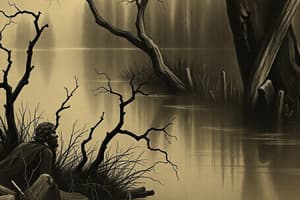Podcast
Questions and Answers
What is the purpose of simplifying the DFA obtained in the previous steps?
What is the purpose of simplifying the DFA obtained in the previous steps?
- To convert the DFA to an NFA
- To add unnecessary states to the DFA
- To reduce the number of states and transitions in the DFA (correct)
- To increase the number of states and transitions in the DFA
In the given example, what is the role of the parameter F for the NFA?
In the given example, what is the role of the parameter F for the NFA?
- It represents the set of initial states in the NFA
- It represents the set of all states in the NFA
- It represents the set of transition functions in the NFA
- It represents the set of final states in the NFA (correct)
Which step is repeated until no further simplification is possible in the process of minimizing the DFA?
Which step is repeated until no further simplification is possible in the process of minimizing the DFA?
- Step 2: Q’ = {q0}
- Step 6: Repeat steps 3-5 (correct)
- Step 3: For each state in Q’, find the states for each input symbol
- Step 1: Q’ = ?
What does Q’ represent in the context of minimizing the DFA?
What does Q’ represent in the context of minimizing the DFA?
In the given example, what is represented by ?'(Transition Function of DFA)?
In the given example, what is represented by ?'(Transition Function of DFA)?
What is the purpose of finding moves from a state on different input symbols when minimizing a DFA?
What is the purpose of finding moves from a state on different input symbols when minimizing a DFA?
What is the main difference between an NFA and a DFA?
What is the main difference between an NFA and a DFA?
How is the epsilon closure of the NFA's start state defined?
How is the epsilon closure of the NFA's start state defined?
What does the transition table in the DFA represent?
What does the transition table in the DFA represent?
How are the DFA's final states determined?
How are the DFA's final states determined?
Flashcards are hidden until you start studying
Study Notes
DFA Simplification
- Simplifying the DFA obtained in previous steps is necessary to reduce the number of states and transitions, making it more efficient and easier to analyze.
NFA Parameters
- The parameter F in the NFA represents the final states of the NFA.
DFA Minimization
- The process of minimizing a DFA involves repeating a step until no further simplification is possible, which is to identify and merge equivalent states.
Minimizing DFA Notation
- Q' represents the set of states in the minimized DFA.
DFA Transition Function
- ?'(Transition Function of DFA) represents the transition function of the minimized DFA, which defines the next state based on the current state and input symbol.
DFA Minimization Purpose
- The purpose of finding moves from a state on different input symbols when minimizing a DFA is to identify and merge equivalent states.
NFA vs DFA
- The main difference between an NFA and a DFA is that an NFA can be in multiple states at once, while a DFA can only be in one state at a time.
Epsilon Closure
- The epsilon closure of the NFA's start state is defined as the set of states that can be reached from the start state by taking zero or more epsilon transitions.
DFA Transition Table
- The transition table in the DFA represents the transition function, which defines the next state based on the current state and input symbol.
DFA Final States
- The DFA's final states are determined by identifying the states that can accept the input string, and are typically marked as accepting or final states.
Studying That Suits You
Use AI to generate personalized quizzes and flashcards to suit your learning preferences.




